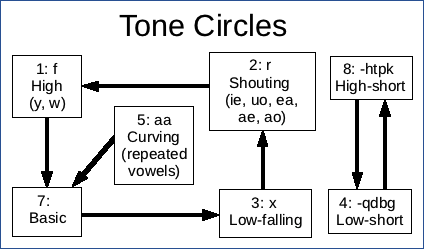Tone sandhi: Difference between revisions
| Line 19: | Line 19: | ||
== Examples in Modern Literal Taiwanese == | == Examples in Modern Literal Taiwanese == | ||
In [[MLT]], most multisyllabic words are written with internal tones already changed. This way, the spelling explicitly reflects tone sandhi and thus grammar. | In [[MLT]], most multisyllabic words are written with internal tones already changed. This way, the spelling explicitly reflects tone sandhi and thus grammar. Let us illustrate the tone change process with some examples: | ||
* {{x|chviar}}-{{x|mng}} → {{x|chviaf'mng}} → {{x|chviafmng}} | * {{x|chviar}}-{{x|mng}} → {{x|chviaf'mng}} → {{x|chviafmng}} | ||
* {{x|køea}}-{{x|cie}} → {{x|køef'cie}} → {{x|køefcie}} | * {{x|køea}}-{{x|cie}} → {{x|køef'cie}} → {{x|køefcie}} | ||
* {{x|siør}}-{{x|ciar}} → {{x|siøf'ciar}} → {{x|siøfciar}} | * {{x|siør}}-{{x|ciar}} → {{x|siøf'ciar}} → {{x|siøfciar}} | ||
Initially, the hyphen keeps syllables separate. After the first step, the [[apostrophe]] delimits syllables that are joined. In the next step, unneeded apostrophes are removed. | Initially, the [[hyphen]] keeps syllables separate. In all three cases, we know the first syllable needs to change tone. After the first step, the [[apostrophe]] delimits syllables that are already joined. In the next step, unneeded apostrophes are removed. | ||
Try using the [[MTL Toolbox]] to "unjoin" these example words into the original syllables: | Try using the [[MTL Toolbox]] to "unjoin" these example words into the original syllables: | ||
| Line 30: | Line 30: | ||
* {{x|hibang}} (see [[polysyllables that become homonyms after conversion to MLT]]) | * {{x|hibang}} (see [[polysyllables that become homonyms after conversion to MLT]]) | ||
Usually, disyllables in MLT are written with the first syllable already changed. However, on the sentence level, plenty of tone change is not explicitly written and must be considered by the speaker. | |||
==Exceptions== | ==Exceptions== | ||
Latest revision as of 14:18, 17 May 2025
Tone sandhi ("sandhi" is from the Sanskrit word for "joining") is the change of tone based on the pronunciation of adjacent words or morphemes.
- In Taiwanese, most syllables will have to change tone (pierntiau) depending on the surrounding words and grammatical function. The rules for this are extensive. Basically, it's a way to join syllables into words as well as to join larger units.
- Almost all verbs and adjectives will change tone to "join" them to whatever is coming next in the sentence, if present.
- The final syllable in a noun doesn't change tone, as long as it's standing alone. (If it's being used as an adjective, see above.)
Basic rules (tone circles)
- If the original tone number is 5 (curving-up tone), pronounce it as tone number 7 (basic).
- If the original tone number is 7 (basic tone), pronounce it as tone number 3 (low-falling).
- If the original tone number is 3 (low-falling), pronounce it as tone number 2 (shouting out).
- If the original tone number is 2 (shouting tone), pronounce it as tone number 1 (high).
- If the original tone number is 1 (high tone), pronounce it as tone number 7 (basic).
- If the original tone number is 8 (high-short), pronounce it as tone number 4 (low-short).
- If the original tone number is 4 (low-short), pronounce it as tone number 8 (high-short).
We admit this is a simplification. Please see Taiwanese Hokkien#Tone sandhi for a more detailed explanation.
Examples in Modern Literal Taiwanese
In MLT, most multisyllabic words are written with internal tones already changed. This way, the spelling explicitly reflects tone sandhi and thus grammar. Let us illustrate the tone change process with some examples:
Initially, the hyphen keeps syllables separate. In all three cases, we know the first syllable needs to change tone. After the first step, the apostrophe delimits syllables that are already joined. In the next step, unneeded apostrophes are removed.
Try using the MTL Toolbox to "unjoin" these example words into the original syllables:
Usually, disyllables in MLT are written with the first syllable already changed. However, on the sentence level, plenty of tone change is not explicitly written and must be considered by the speaker.
Exceptions
- most nouns
- ciaf, hiaf, zef, hef, ciahniq', hiahniq'
- symmih, ui-symmih, (see Taiguo_Siong'iong_460-ji#Demonstrative_pronouns)
- basic tone + ar. (The basic tone syllable is excepted).
- surnames before `siensvy: Taan`Siensvy
- some compound words: tøe-tang, thvy-kngf, sym-sngf (the hyphen is used to hint)
Further details
- more details on double tone sandhi, cases involving suffix ar (仔), and adjective triplication can be found at Wikipedia: Taiwanese Hokkien#Tone sandhi
- syllables ending in "h" are usually pronounced in shouting tone, such as in bahzaxng, but not bøeq
- khix ("to go") is usually treated as if originally "khiq"
